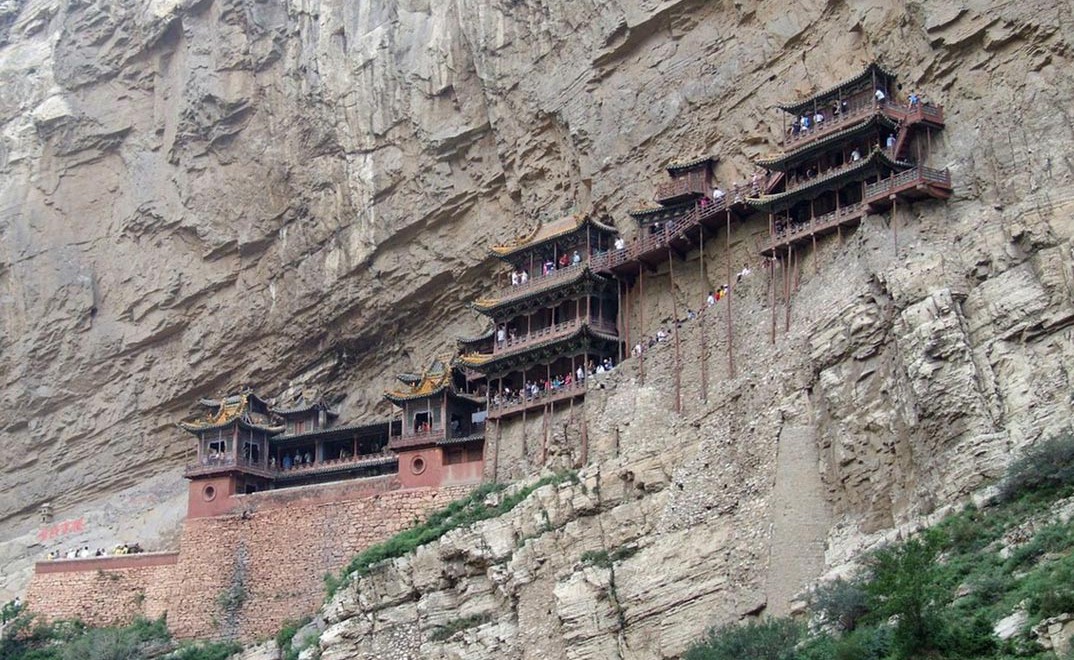
The Precariously Hanging Monastery of Mount Heng
Hengshan, or Mount Heng, which is located in Shanxi province, is one of China’s Five Great Mountains. Pinned to the side of its cliff face is the Xuan Kong Si, also known as the Hanging Monastery. Despite its precarious position, the monastery has been ‘hanging’ in its original position for more than 1,500 years, a testament to the ingenuity of its builders.
The Hanging Monastery is said to have been built in 491 AD, during the late Northern Wei Dynasty. It is commonly believed that the building of the monastery was initiated by a single individual, a monk by the name of Liao Ran. In time, however, Liao Ran received help from Taoist builders, who were drawn to the site due to its peaceful and serene atmosphere. The site was perfect for those engaged in meditation, as noises from the ground did not reach such lofty heights. In addition, its height ensured that the monastery was safe from floods. The Hanging Monastery is also protected from rain, snow and sun as it is sheltered by the mountain’s peak. This is one of the reasons for the monastery’s continual existence over the centuries.
In order to provide support for the monastery, holes were first drilled into the side of the cliff. Wooden pillars were then half inserted into the rock as the foundation. The monastery was then built on top of these pillars, with additional support from the rock at the back of the building. Some have claimed that the wooden pillars were not present when the monastery was being built, and that the building would be able to support itself should the pillars be taken away. The pillars, it is further claimed, were added later on, as visitors did not dare climb up to the monastery for fear that it would fall. It was subsequently enlarged over the centuries, and was also restored in 1900 during the Qing Dynasty.
Apart from being an architectural marvel, the Hanging Monastery is also a unique structure from a religious point of view. The monastery is dedicated to three religious systems – Buddhism, Taoism, and Confucianism, all of which co-exist harmoniously in the building. In the San Jiao Hall, for instance, the statue of the Sakyamuni Buddha is enshrined together with that of Lao Zi and Confucius. These are the founders of Buddhism, Taoism and Confucianism respectively, their existence side-by-side showing the harmony between the three systems in this sacred space.
It has been claimed that the Hanging Monastery once served as a sort of ‘transit station’ for travellers who passed through the area, due to the remote nature of the Hengshan area. It was at this place that weary traveller could get a meal and some rest before setting out again. Due to the prevalence of religion at the time, it is said that people were reluctant to enter the places of worship of religions other than their own. To ease these travellers’ anxiety, the three major religions of China were enshrined in the Hanging Monastery. In this way, more travellers could stay at the monastery for a while before resuming their journey.
It has been claimed that the Hanging Monastery once served as a sort of ‘transit station’ for travellers who passed through the area, due to the remote nature of the Hengshan area. It was at this place that weary traveller could get a meal and some rest before setting out again. Due to the prevalence of religion at the time, it is said that people were reluctant to enter the places of worship of religions other than their own. To ease these travellers’ anxiety, the three major religions of China were enshrined in the Hanging Monastery. In this way, more travellers could stay at the monastery for a while before resuming their journey.
Throughout the monastery, there are about 80 sculptures of important Buddhist, Taoist and Confucian individuals. These figures are made of various materials, including copper, bronze, iron, terracotta and stone, and are carved vividly. In the San Sheng Hall, for example, there is a seated statue of the Buddha. At his sides are a number of his disciples, portrayed as standing submissively to their master. There are six main halls and 34 lesser halls, making a total of 40 halls, in the monastery. These halls are linked by a maze of passageways.
Today, the Hanging Monastery is probably not the best site for meditation due to its transformation into a tourist attraction. Its seemingly impossible engineering alone has attracted numerous people to see the Hanging Monastery for themselves. Others are perhaps inspired by the co-existence of Buddhism, Taoism and Confucianism. Nevertheless, the precarious position of the structure is certain to cause some to think twice before visiting the Hanging Monastery, and a trip there is certainly not for the faint of heart.
All Content and Images Courtesy of ancient-origins.net

